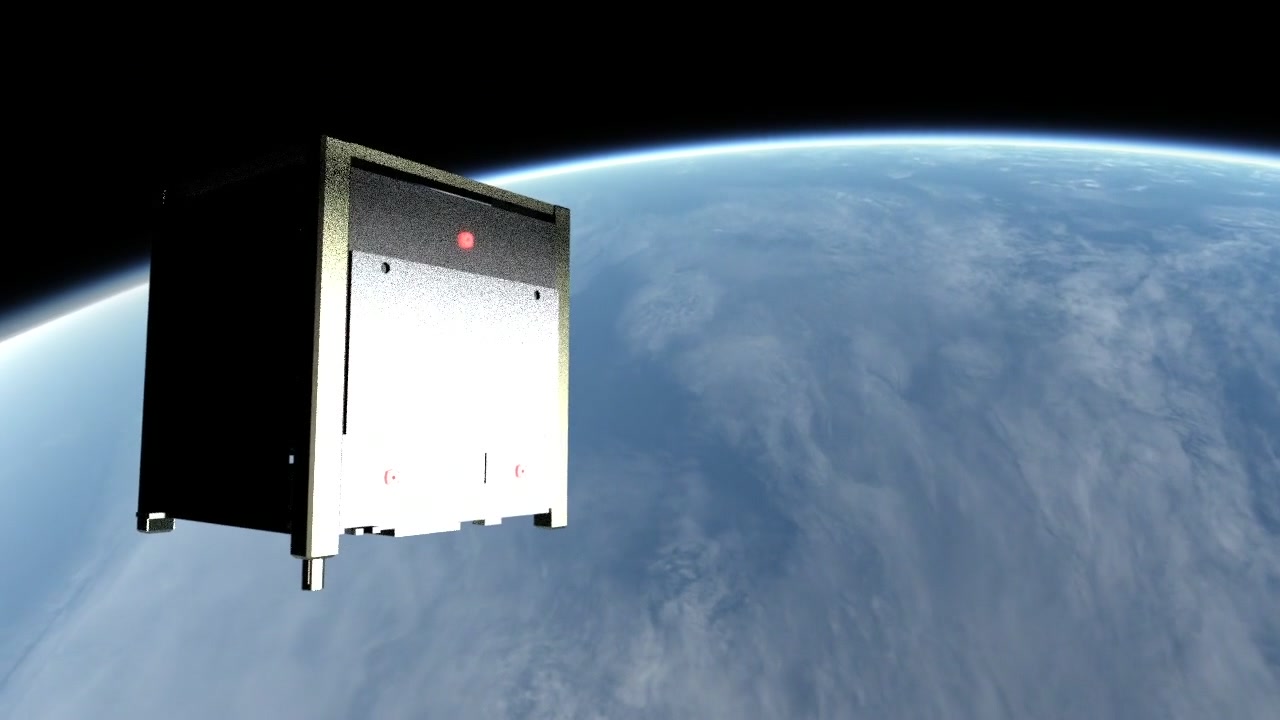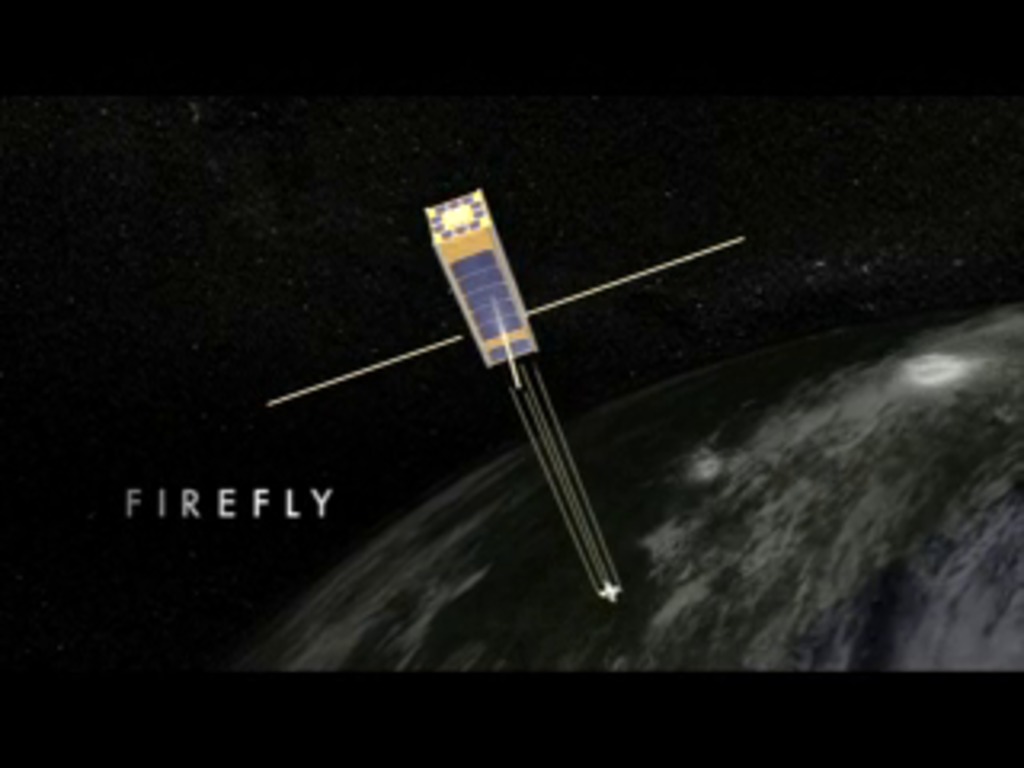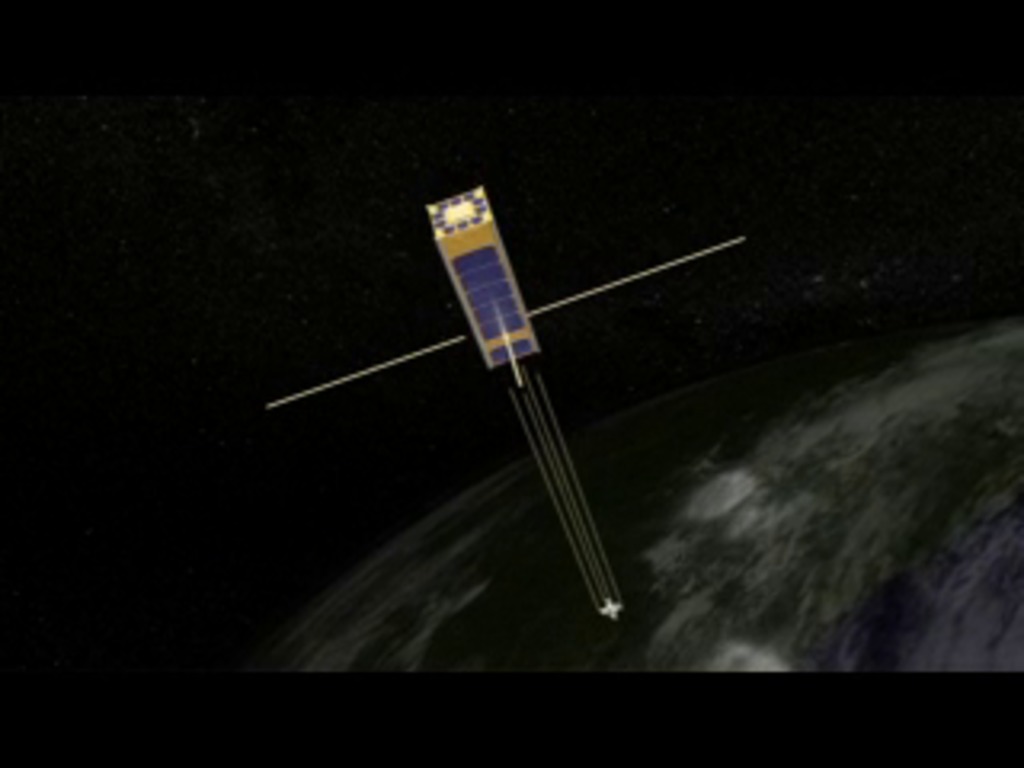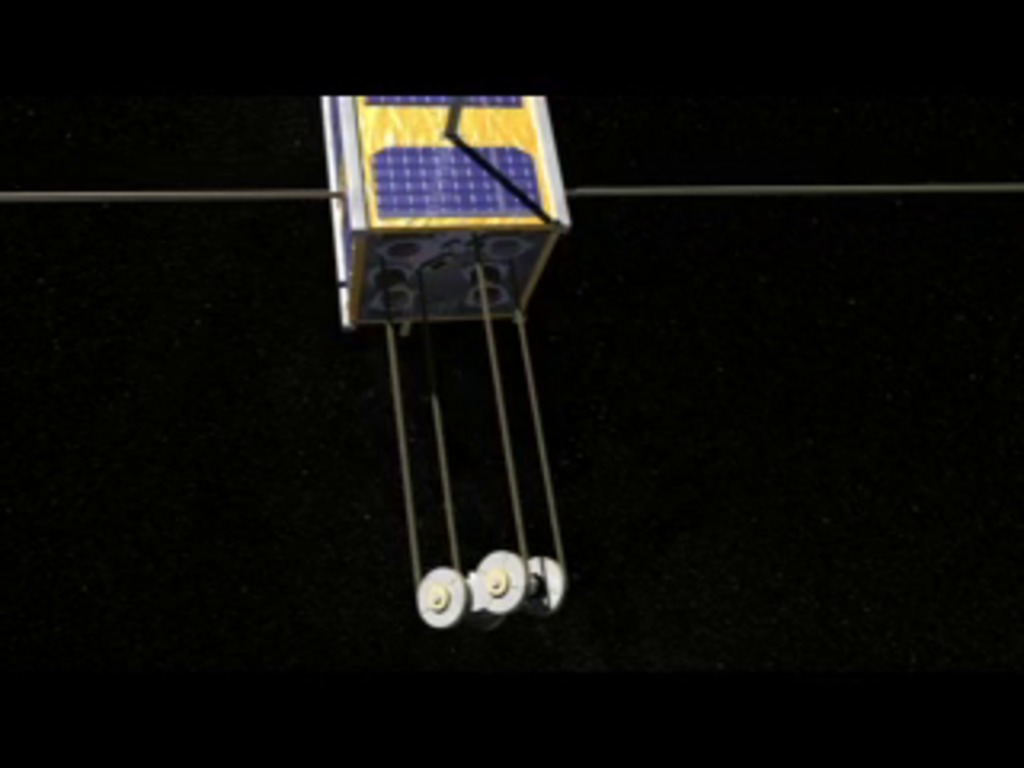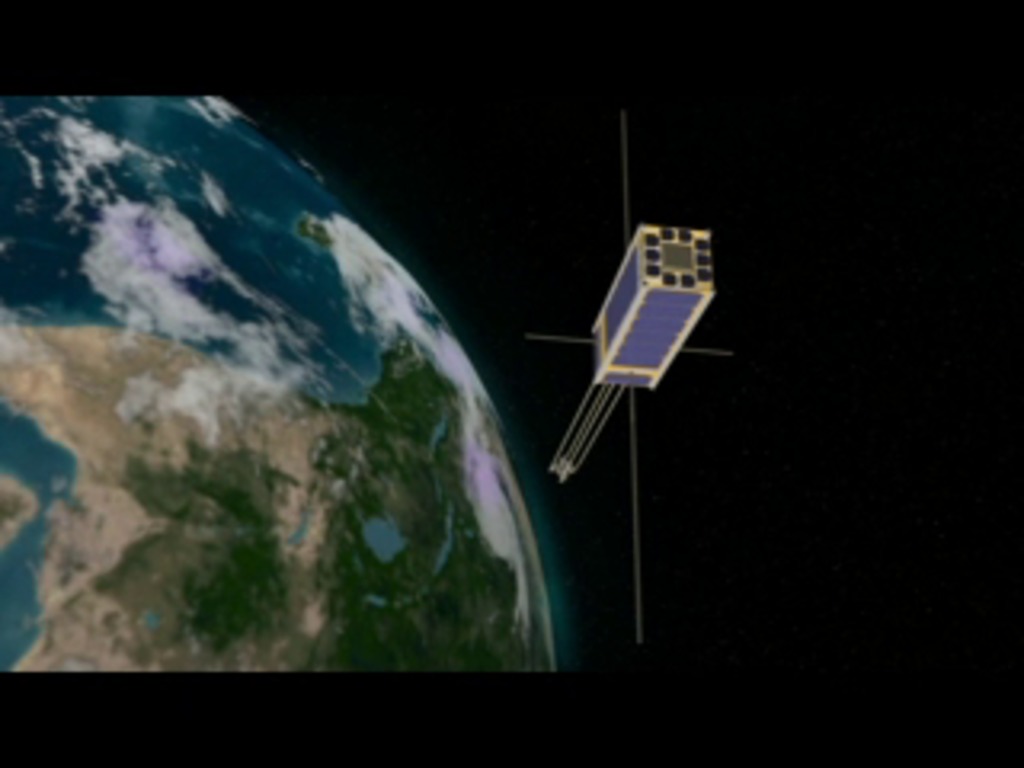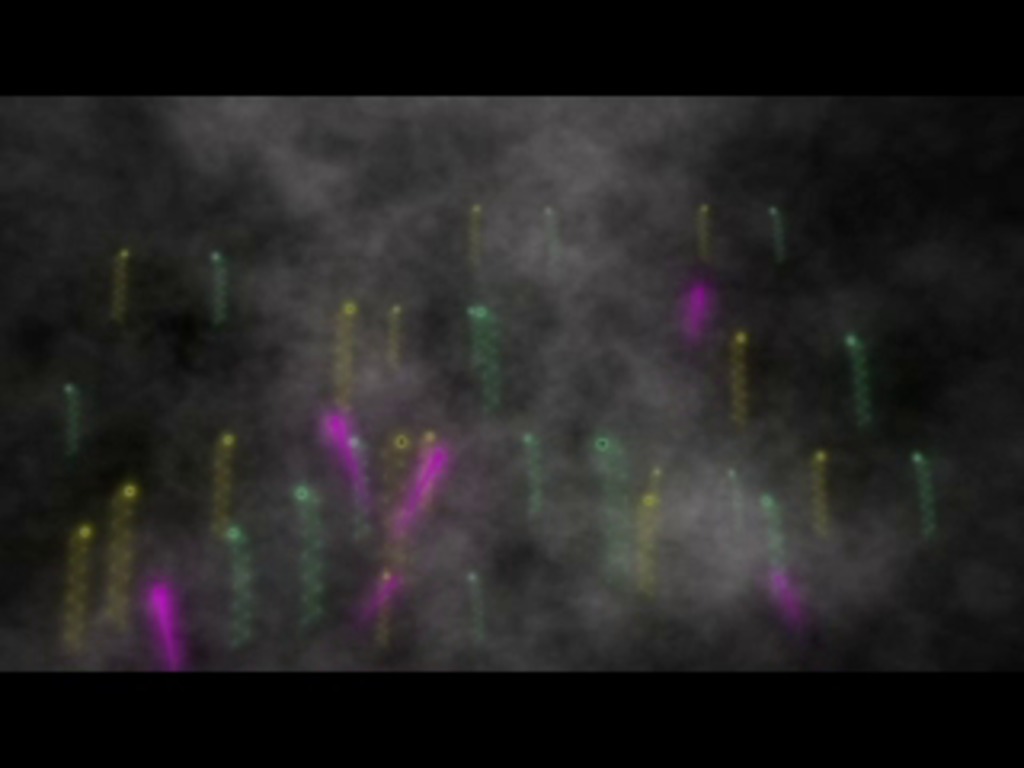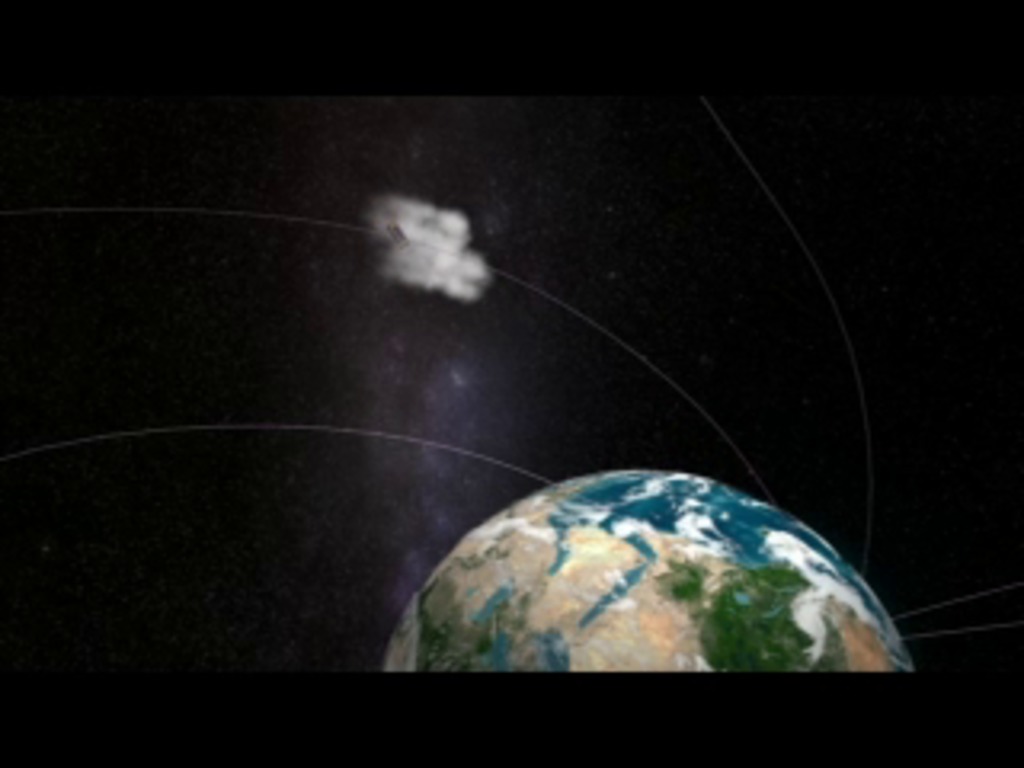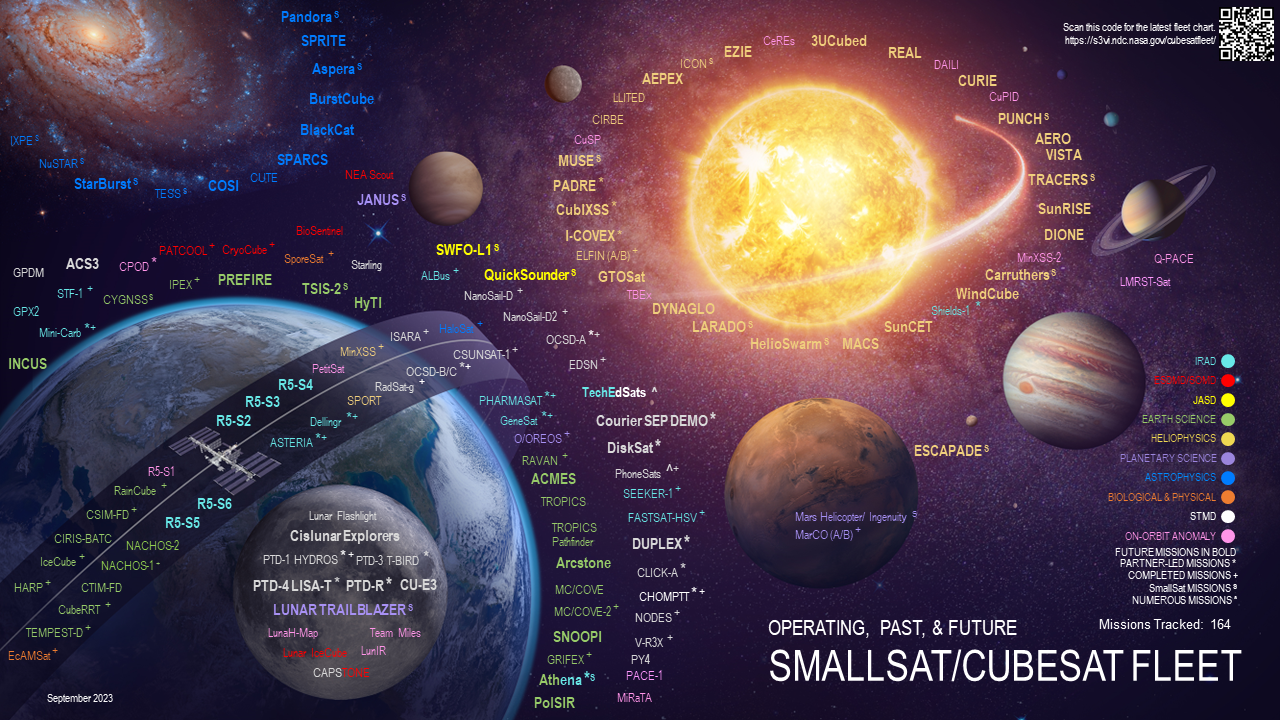CubeSats
Overview
CubeSats are a class of nanosatellites that use a standard size and form factor. The standard CubeSat size uses a "one unit" or "1U" measuring 10x10x10 cms and is extendable to larger sizes; 1.5, 2, 3, 6, and even 12U. Originally developed in 1999 by California Polytechnic State University at San Luis Obispo (Cal Poly) and Stanford University to provide a platform for education and space exploration. The development of CubeSats has advanced into it's own industry with government, industry and academia collaborating for ever increasing capabilities. CubeSats now provide a cost effective platform for science investigations, new technology demonstrations and advanced mission concepts using constellations, swarms disaggregated systems.
BurstCube
BurstCube Animations
Go to this pageBurstCube is a mission under development at NASA’s Goddard Space Flight Center in Greenbelt, Maryland. This CubeSat will detect short gamma-ray bursts, which are important sources for gravitational wave discoveries and multimessenger astronomy. The satellite is expected to launch in 2023. ||
BurstCube Integration
Go to this pageBurstCube is a mission under development at NASA’s Goddard Space Flight Center in Greenbelt, Maryland. This CubeSat will detect short gamma-ray bursts, which are important sources for gravitational wave discoveries and multimessenger astronomy. The satellite is expected to launch in March 2024. ||
BurstCube Completes Thermal Vacuum Testing
Go to this pageBurstCube is a mission developed at NASA’s Goddard Space Flight Center in Greenbelt, Maryland. The spacecraft is slated for takeoff in March 2024 from NASA’s Kennedy Space Center in Florida aboard a resupply mission to the International Space Station. This CubeSat will detect short gamma-ray bursts, brief flashes of the highest-energy form of light. Dense stellar remnants called neutron stars create these bursts when they collide with other neutron stars or black holes. Short gamma-ray bursts, which last less than 2 seconds, are important sources for gravitational wave discoveries and multimessenger astronomy. As BurstCube orbits, it will experience major temperature swings every 90 minutes as it passes in and out of daylight. The team evaluated how the spacecraft will operate in these new conditions using a thermal vacuum chamber at Goddard, shown in these images and video, where temperatures ranged from minus 4 to 113 degrees Fahrenheit (minus 20 to 45 Celsius). ||
BurstCube Gets Its Solar Panels
Go to this pageEngineers work on the BurstCube mission’s solar panels in this video. The first shot pans across the spacecraft as it rests on a table, panels unfolded. The second shot starts close to the spacecraft, then pulls back. The third shot shows NASA engineers Julie Cox and Kate Gasaway attaching one of the panels. The fourth shot shows one of the unattached panels sitting on a piece of foil on a blue tabletop. The fifth shot is a wider view of the unattached panel with Cox in view. The sixth and seventh shots show Cox and Gasaway attaching the second panel to the other side of the spacecraft, from the side and above, respectively. The final shot shows a test deployment of the solar panels. Credit: NASA/Sophia Roberts || BurstCube_Solar_Panel_Install_4k.00060_print.jpg (1024x540) [110.8 KB] || BurstCube_Solar_Panel_Install_4k.00060_searchweb.png (320x180) [65.1 KB] || BurstCube_Solar_Panel_Install_4k.00060_thm.png (80x40) [5.4 KB] || BurstCube_Solar_Panel_Install_4k.webm (4096x2160) [28.3 MB] || BurstCube_Solar_Panel_Install_Clips4k_ProRes.mov (4096x2160) [7.6 GB] || BurstCube_Solar_Panel_Install_4k.mp4 (4096x2160) [1.0 GB] ||
BurstCube Completes Magnetic Calibration
Go to this pageBurstCube is a mission developed at NASA’s Goddard Space Flight Center in Greenbelt, Maryland. It is expected to launch in March 2024. This CubeSat will detect short gamma-ray bursts, brief flashes of the highest-energy form of light. Dense stellar remnants called neutron stars create these bursts when they collide with other neutron stars or black holes. Short gamma-ray bursts, which last less than 2 seconds, are important sources for gravitational wave discoveries and multimessenger astronomy. BurstCube will use Earth’s magnetic field to orientate itself as it scans the sky. To do so, the mission team had to map the spacecraft’s own magnetic field using a special facility at NASA’s Wallops Flight Facility in Virginia. The magnetic calibration chamber generates a known magnetic field that cancels out Earth’s. The team's measurements of BurstCube’s field in the chamber will help figure out where the satellite is pointing once in space, so scientists can locate gamma-ray bursts and tell other observatories where to look. ||
BurstCube Completes an Open-Sky Test
Go to this pageThis video shows engineers conducting an open-sky test of the BurstCube satellite’s GPS at NASA’s Goddard Space Flight Center in Greenbelt, Maryland. The first shot shows Benjamin Nold (NASA) and Justin Clavette (SSAI) sitting around the spacecraft on a rooftop while Kate Gasaway (NASA) works in the background. The second shot shows Gasaway and Clavette looking at a laptop in the background, with BurstCube in the foreground. The third shot shows birds landing on an antenna on the rooftop. The fourth shot shows Clavette and Nold crouched next to the BurstCube satellite. The fifth shot shows Gasaway typing on the laptop. The sixth shot is a closer view of Gasaway and Clavette looking at the laptop. The eighth shot shows some of the electronics used to monitor the spacecraft. The ninth shot shows the data readout from the spacecraft on the laptop. The final shots show birds flying over the rooftop. Credit: NASA/Sophia Roberts || Open_Air_test_4k.01440_print.jpg (1024x540) [103.1 KB] || Open_Air_test_4k.01440_searchweb.png (320x180) [74.5 KB] || Open_Air_test_4k.01440_web.png (320x168) [70.2 KB] || Open_Air_test_4k.01440_thm.png (80x40) [5.8 KB] || Open_Air_test_4k.webm (4096x2160) [27.4 MB] || Open_Air_test_4k.mp4 (4096x2160) [891.4 MB] || BurstCube_Open_Air_test_4k_ProRes.mov (4096x2160) [6.5 GB] ||
BurstCube Deploys from International Space Station
Go to this pageThe shoebox-sized BurstCube and SNOOPI (Signals of Opportunity P-band Investigation) satellites entered low-Earth orbit from the International Space Station on April 18, 2024.BurstCube will study gamma-ray bursts, the universe’s most powerful explosions. SNOOPI will demonstrate technology for measuring soil moisture. These CubeSats launched to the space station aboard SpaceX’s 30th Commercial Resupply Services mission on March 21, 2024 ||
Lunar IceCube
Artemis I
Go to this pageNASA’s Artemis missions are returning humanity to the Moon and beginning a new era of lunar exploration. This year, the agency plans to launch the Artemis I mission, an uncrewed test flight that will take a human-rated spacecraft farther than any before. ||
SunRISE
SunRISE Beauty Pass
Go to this pageA coronal mass ejection (CME) erupts from the Sun and sends Type II radio bursts ahead of it. SunRISE measures the radio bursts and transmits the data to NASA’s Deep Space Network. Type II radio bursts are the earliest indicators of shocks from a solar eruption and can provide information on solar energetic particle (SEP) events. || SUNRISE-shot1_v06_4k_30fps_ProRes422.00240_print.jpg (1024x576) [172.5 KB] || SUNRISE-shot1_v06_4k_30fps_ProRes422.00240_searchweb.png (320x180) [87.2 KB] || SUNRISE-shot1_v06_4k_30fps_ProRes422.00240_thm.png (80x40) [5.9 KB] || SUNRISE-shot1_v06_4k_30fps_ProRes422.mov (3840x2160) [695.8 MB] || SUNRISE-shot1_v06_4k_30fps_h264.mp4 (3840x2160) [13.7 MB] || SUNRISE-shot1_v06_4k (3840x2160) [32.0 KB] || SUNRISE-shot1_v06_4k_30fps_ProRes422.webm (3840x2160) [5.3 MB] ||
IceCube
During a Year in Orbit, IceCube Created a New Map of Earth's Clouds
Go to this pageMusic: Charming Noise by Adrien Sahuc [SACEM], Benjamin Sahuc [SACEM]Complete transcript available. || Screen_Shot_2018-05-14_at_5.20.10_PM.png (1536x858) [868.8 KB] || Screen_Shot_2018-05-14_at_5.20.10_PM_print.jpg (1024x572) [51.8 KB] || Screen_Shot_2018-05-14_at_5.20.10_PM_searchweb.png (320x180) [39.5 KB] || Screen_Shot_2018-05-14_at_5.20.10_PM_thm.png (80x40) [3.9 KB] || YOUTUBE_1080_12957_IceCube_youtube_1080.mp4 (1920x1080) [127.0 MB] || 12957_IceCube.webm (960x540) [31.6 MB] || 12957_IceCube_large.mp4 (1920x1080) [80.1 MB] || a012957_IceCubeviz_textfree.mov (1920x1080) [2.1 GB] || 12957_IceCube.en_US.srt [1.2 KB] || 12957_IceCube.en_US.vtt [1.2 KB] ||
Ice Cube Cubesat Measures High Altitude Atmospheric Ice
Go to this pageMean Cloud Ice data as measured from Ice Cube from July through August 2017. || ice_cube_data.1000_print.jpg (1024x576) [53.1 KB] || ice_cube_data.1000_searchweb.png (320x180) [38.5 KB] || ice_cube_data.1000_thm.png (80x40) [4.1 KB] || ice_cube_data.mp4 (1920x1080) [136.5 MB] || ice_cube_data (1920x1080) [256.0 KB] || ice_cube_data.webm (1920x1080) [8.1 MB] || This visualization shows 2 months of high altitude atomspheric ice as measured from the Ice Cube Cubsesat satelllite. ||
NASA Releases a Tiny Satellite to Study Ice Clouds
Go to this pageMusic: Devotion by David Goldsmith [PRS]Complete transcript available. || LARGE_MP4-IceCubeDeployment_large.00428_print.jpg (1024x576) [79.3 KB] || LARGE_MP4-IceCubeDeployment_large.00428_searchweb.png (320x180) [85.3 KB] || LARGE_MP4-IceCubeDeployment_large.00428_thm.png (80x40) [5.9 KB] || APPLE_TV-IceCubeDeployment_appletv.m4v (1280x720) [14.9 MB] || LARGE_MP4-IceCubeDeployment_large.mp4 (1920x1080) [34.7 MB] || NASA_TV-IceCubeDeployment.mpeg (1280x720) [110.0 MB] || WEBM-IceCubeDeployment.webm (960x540) [13.6 MB] || YOUTUBE_HQ-IceCubeDeployment_youtube_hq.mov (1920x1080) [98.4 MB] || APPLE_TV-IceCubeDeployment_appletv_subtitles.m4v (1280x720) [14.9 MB] || IceCube_Deployment.en_US.srt [567 bytes] || IceCube_Deployment.en_US.vtt [578 bytes] ||
MiRaTA
NASA CubeSat to Test Miniaturized Weather Satellite Technology
Go to this pageMusic: Let's Shape the Future by Tiny MusicComplete transcript available. || MiRaTA-v5-27OCT.00929_print.jpg (1024x576) [79.3 KB] || MiRaTA-v5-27OCT.00929_searchweb.png (320x180) [67.0 KB] || MiRaTA-v5-27OCT.00929_thm.png (80x40) [5.3 KB] || MiRaTA-v5-27OCT.mp4 (1920x1080) [235.1 MB] || MiRaTA-v5-27OCT.webm (1920x1080) [20.3 MB] || ESTO.en_US.srt [2.1 KB] || ESTO.en_US.vtt [2.1 KB] ||
Dellingr
NASA Set To Launch Shoebox-sized Satellite Studying Earth's Upper Atmosphere
Go to this pageNASA scientists and engineers named their new CubeSat after the mythological Norse god of the dawn. Now, just days from launch, they are confident the shoebox-sized satellite Dellingr will live up to its name and inaugurate a new era for scientists wanting to use small, highly reliable satellites to carry out important, and in some cases, never-before-tried science.Dellingr will study how the ionosphere, a region in Earth’s upper atmosphere, interacts with the Sun. Before launch, Dellingr is required to visit to the Magnetic Test Facility at NASA Goddard to test the spacecraft's magnetometers - key instruments for measuring the direction and strength of the magnetic fields that surround Earth.The spacecraft is scheduled to launch this August aboard a SpaceX Falcon 9 rocket to the International Space Station where it will be deployed later into a low-Earth orbit. ||
CANYVAL
CANYVAL-X: CubeSat Astronomy by NASA and Yonsei using Virtual Telescope Alignment eXperiment
Go to this pageCANYVAL-X matures formation alignment technology enabling the next-generation of distributed space virtual telescopes.For the CANYVAL-X fact sheet, click here. || CANYVALX.jpeg (1280x720) [67.7 KB] || CANYVALX_print.jpg (1024x576) [76.4 KB] || CANYVALX_searchweb.png (320x180) [53.3 KB] || CANYVALX_web.png (320x180) [53.3 KB] || CANYVALX_thm.png (80x40) [4.9 KB] || YOUTUBE_HQ_CANYVALX_youtube_hq.mov (1280x720) [83.7 MB] || APPLE_TV_CANYVALX_appletv.m4v (1280x720) [62.9 MB] || WEBM_CANYVALX.webm (960x540) [37.6 MB] || WMV_CANYVALX_HD.wmv (1280x720) [19.2 MB] || CANYVALX_prores.mov (1280x720) [1.2 GB] || NASA_PODCAST_CANYVALX_ipod_sm.mp4 (320x240) [21.8 MB] ||
Firefly
The small satellite, with a big mission, is appropriately named "Firefly". Sponsored by the National Science Foundation (NSF), the pint-sized satellite will study the most powerful natural particle accelerator on Earth, lightning, when it launches from the Marshall Islands aboard an Air Force Falcon 1E rocket vehicle next year. In particular, Firefly will focus on Terrestrial Gamma-ray Flashes (TGFs), a little understood phenomenon first discovered by NASA's Compton Gamma-Ray Observatory in the early 1990s.
Although no one knows why, it appears these flashes of gamma rays that were once thought to occur only far out in space near black holes or other high-energy cosmic phenomena are somehow linked to lightning.
Using measurements gathered by Firefly's instruments, Goddard scientist Doug Rowland and his collaborators, Universities Space Research Association in Columbia, Md., Siena College, located near Albany, N.Y., and the Hawk Institute for Space Studies in Pocomoke City, Md., hope to answer what causes these high-energy flashes. In particular, they want to find out if lightning triggers them or if they trigger lightning. Could they be responsible for some of the high-energy particles in the Van Allen radiation belts, which damage satellites? Firefly is expected to observe up to 50 lightning strokes per day, and about one large TGF every couple days.
NASA-led Firefly Mission to Study Lightning
Go to this pageSomewhere on Earth, there's always a lightning flash. The globe experiences lightning some 50 times a second, yet the details of what initiates this common occurrence and what effects it has on the atmosphere – lightning may be linked to incredibly powerful and energetic bursts called terrestrial gamma ray flashes, or TGFs — remains a mystery. In mid-November, a football-sized mission called Firefly, which is funded by the National Science Foundation, will launch into space to study lightning and these gamma ray flashes from above. The NSF CubeSat program represents a low cost access to space approach to performing high-quality, highly targeted science on a smaller budget than is typical of more comprehensive satellite projects, which have price tags starting at $100 million. The CubeSat Firefly, by focusing its science goals, will carry out its mission in a much smaller package and at a considerably lower cost. The Firefly mission also emphasizes student involvement as part of the ongoing effort to train the next generation of scientists and engineers. Students at Siena College, in Loudonville, N.Y., and the University of Maryland Eastern Shore, in Princess Anne, Md., were involved in all phases of the Firefly mission. The window for Firefly launch opens on Nov. 19, 2013, and it is scheduled to launch with 27 other cubesat missions, as well as a NASA experiment called the Total solar irradiance Calibration Transfer Experiment, or TCTE, which will continue measurements from space of the total energy output of the sun. ||
Firefly Beauty Pass
Go to this pageThe small satellite, with a big mission, is appropriately named "Firefly." Sponsored by the National Science Foundation (NSF), the pint-sized satellite will study the most powerful natural particle accelerator on Earth - lightning - when it launches from the Marshall Islands aboard an Air Force Falcon 1E rocket vehicle next year. In particular, Firefly will focus on Terrestrial Gamma-ray Flashes (TGFs), a little understood phenomenon first discovered by NASA's Compton Gamma-Ray Observatory in the early 1990s.Although no one knows why, it appears these flashes of gamma rays that were once thought to occur only far out in space near black holes or other high-energy cosmic phenomena are somehow linked to lightning.Using measurements gathered by Firefly's instruments, Goddard scientist Doug Rowland and his collaborators - Universities Space Research Association in Columbia, Md., Siena College, located near Albany, N.Y., and the Hawk Institute for Space Studies in Pocomoke City, Md. - hope to answer what causes these high-energy flashes. In particular, they want to find out if lightning triggers them or if they trigger lightning. Could they be responsible for some of the high-energy particles in the Van Allen radiation belts, which damage satellites? Firefly is expected to observe up to 50 lightning strokes per day, and about one large TGF every couple days. ||
Firefly Deployment
Go to this pageThe small satellite, with a big mission, is appropriately named "Firefly." Sponsored by the National Science Foundation (NSF), the pint-sized satellite will study the most powerful natural particle accelerator on Earth - lightning - when it launches from the Marshall Islands aboard an Air Force Falcon 1E rocket vehicle next year. In particular, Firefly will focus on Terrestrial Gamma-ray Flashes (TGFs), a little understood phenomenon first discovered by NASA's Compton Gamma-Ray Observatory in the early 1990s.Although no one knows why, it appears these flashes of gamma rays that were once thought to occur only far out in space near black holes or other high-energy cosmic phenomena are somehow linked to lightning.fly's instruments, Goddard scientist Doug Rowland and his collaborators - Universities Space Research Association in Columbia, Md., Siena College, located near Albany, N.Y., and the Hawk Institute for Space Studies in Pocomoke City, Md. - hope to answer what causes these high-energy flashes. In particular, they want to find out if lightning triggers them or if they trigger lightning. Could they be responsible for some of the high-energy particles in the Van Allen radiation belts, which damage satellites? Firefly is expected to observe up to 50 lightning strokes per day, and about one large TGF every couple days. ||
Firefly in Orbit
Go to this pageThe small satellite, with a big mission, is appropriately named "Firefly." Sponsored by the National Science Foundation (NSF), the pint-sized satellite will study the most powerful natural particle accelerator on Earth - lightning - when it launches from the Marshall Islands aboard an Air Force Falcon 1E rocket vehicle next year. In particular, Firefly will focus on Terrestrial Gamma-ray Flashes (TGFs), a little understood phenomenon first discovered by NASA's Compton Gamma-Ray Observatory in the early 1990s.Although no one knows why, it appears these flashes of gamma rays that were once thought to occur only far out in space near black holes or other high-energy cosmic phenomena are somehow linked to lightning.fly's instruments, Goddard scientist Doug Rowland and his collaborators - Universities Space Research Association in Columbia, Md., Siena College, located near Albany, N.Y., and the Hawk Institute for Space Studies in Pocomoke City, Md. - hope to answer what causes these high-energy flashes. In particular, they want to find out if lightning triggers them or if they trigger lightning. Could they be responsible for some of the high-energy particles in the Van Allen radiation belts, which damage satellites? Firefly is expected to observe up to 50 lightning strokes per day, and about one large TGF every couple days. ||
Radiation Generated in Electric Fields Over Thunderstorms
Go to this pageThe small satellite, with a big mission, is appropriately named "Firefly." Sponsored by the National Science Foundation (NSF), the pint-sized satellite will study the most powerful natural particle accelerator on Earth - lightning - when it launches from the Marshall Islands aboard an Air Force Falcon 1E rocket vehicle next year. In particular, Firefly will focus on Terrestrial Gamma-ray Flashes (TGFs), a little understood phenomenon first discovered by NASA's Compton Gamma-Ray Observatory in the early 1990s.Although no one knows why, it appears these flashes of gamma rays that were once thought to occur only far out in space near black holes or other high-energy cosmic phenomena are somehow linked to lightning.fly's instruments, Goddard scientist Doug Rowland and his collaborators - Universities Space Research Association in Columbia, Md., Siena College, located near Albany, N.Y., and the Hawk Institute for Space Studies in Pocomoke City, Md. - hope to answer what causes these high-energy flashes. In particular, they want to find out if lightning triggers them or if they trigger lightning. Could they be responsible for some of the high-energy particles in the Van Allen radiation belts, which damage satellites? Firefly is expected to observe up to 50 lightning strokes per day, and about one large TGF every couple days. ||
Firefly Sees Electrons Populate the Radiation Belts
Go to this pageThe small satellite, with a big mission, is appropriately named "Firefly." Sponsored by the National Science Foundation (NSF), the pint-sized satellite will study the most powerful natural particle accelerator on Earth - lightning - when it launches from the Marshall Islands aboard an Air Force Falcon 1E rocket vehicle next year. In particular, Firefly will focus on Terrestrial Gamma-ray Flashes (TGFs), a little understood phenomenon first discovered by NASA's Compton Gamma-Ray Observatory in the early 1990s.Although no one knows why, it appears these flashes of gamma rays that were once thought to occur only far out in space near black holes or other high-energy cosmic phenomena are somehow linked to lightning.fly's instruments, Goddard scientist Doug Rowland and his collaborators - Universities Space Research Association in Columbia, Md., Siena College, located near Albany, N.Y., and the Hawk Institute for Space Studies in Pocomoke City, Md. - hope to answer what causes these high-energy flashes. In particular, they want to find out if lightning triggers them or if they trigger lightning. Could they be responsible for some of the high-energy particles in the Van Allen radiation belts, which damage satellites? Firefly is expected to observe up to 50 lightning strokes per day, and about one large TGF every couple days. ||
General Information
NASA's SmallSat & Cubesat Fleet
Go to this pageNASA's current SmallSat and CubeSat fleet || NASA_SmallSat_Fleet.png (1280x720) [1.9 MB] || NASA_SmallSat_Fleet_print.jpg (1024x576) [246.2 KB] || NASA_SmallSat_Fleet_searchweb.png (320x180) [104.9 KB] || NASA_SmallSat_Fleet_thm.png (80x40) [7.1 KB] ||
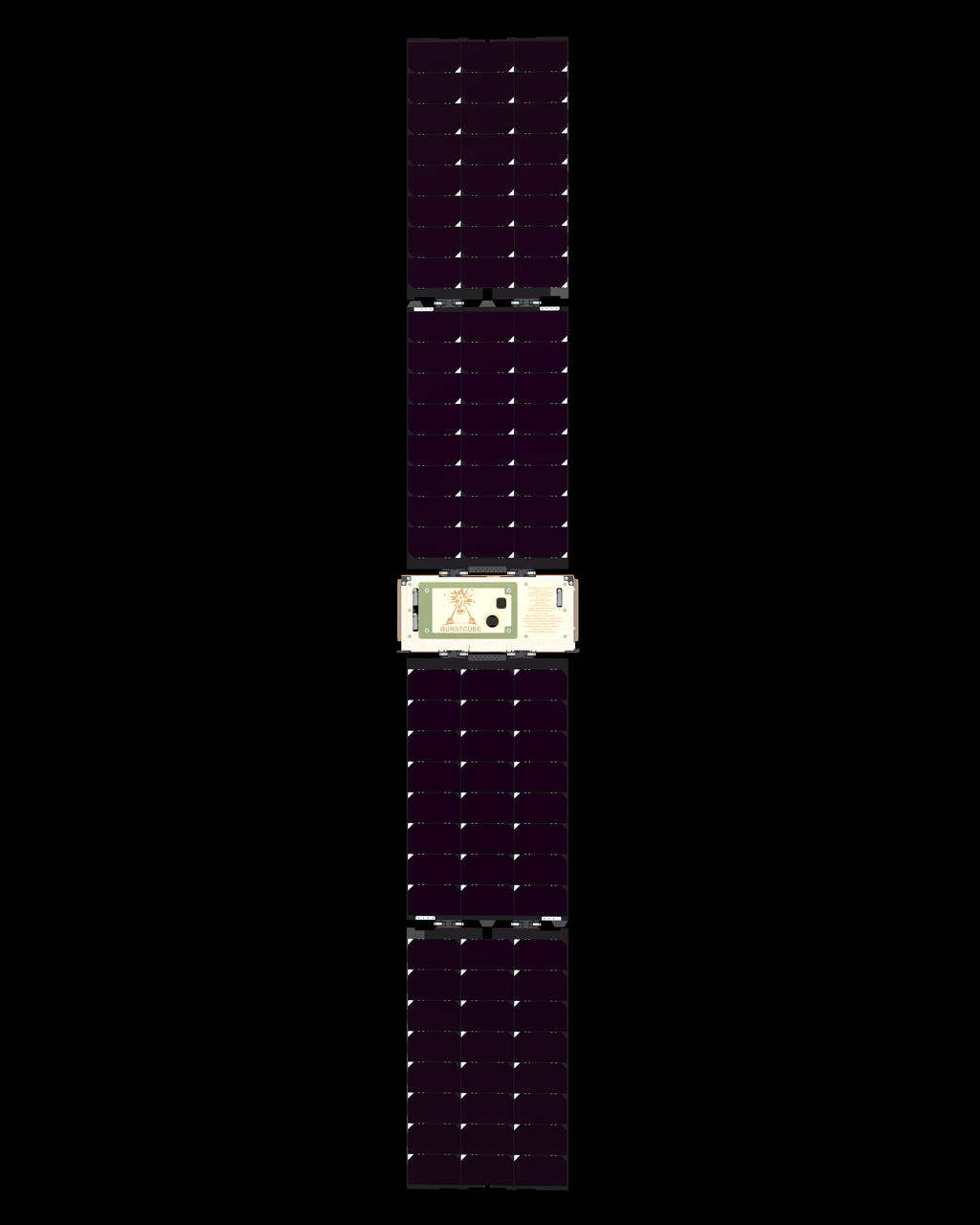
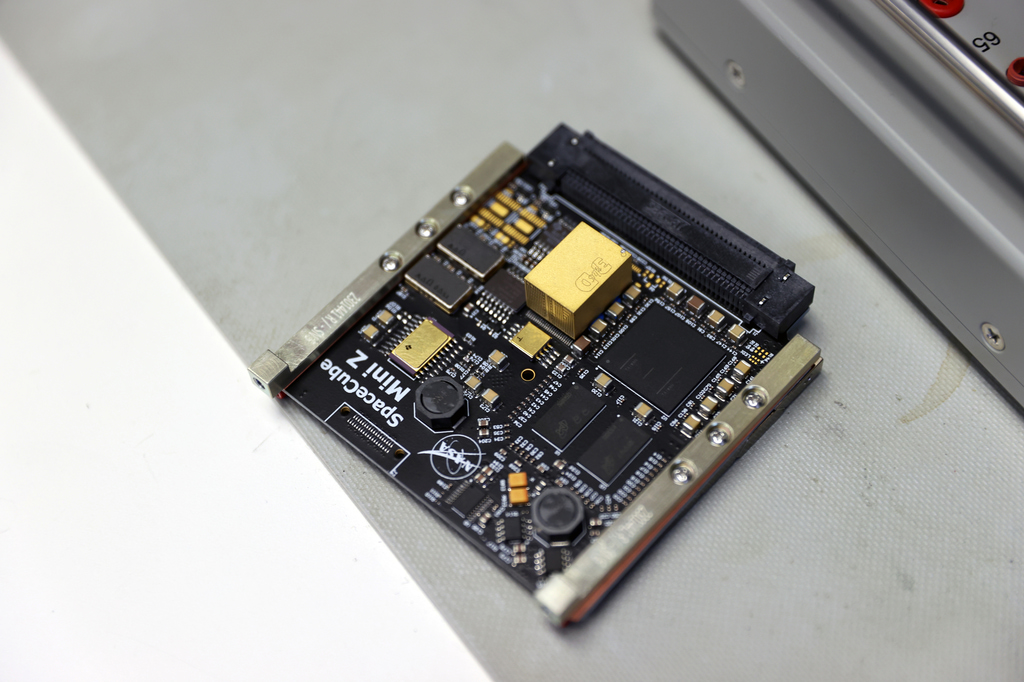
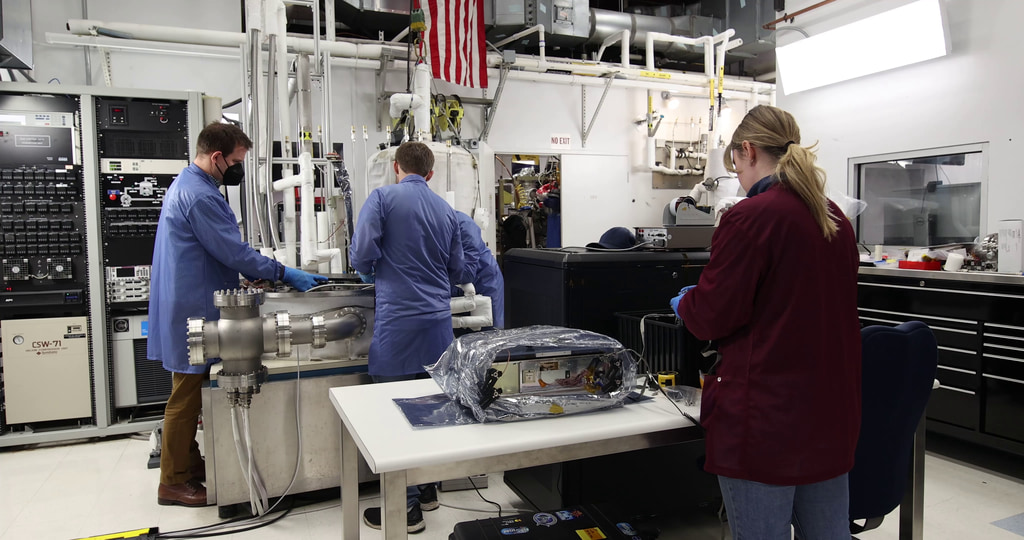
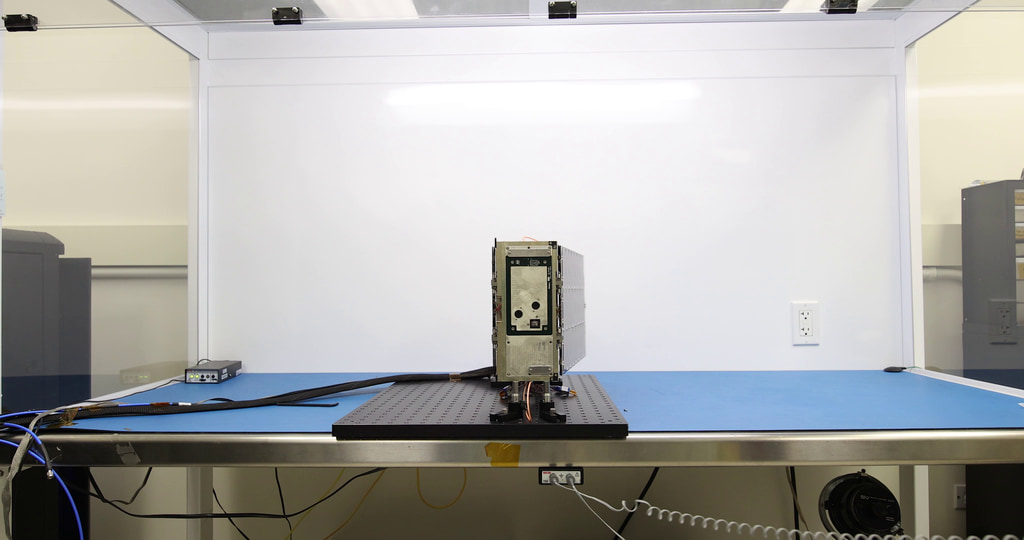
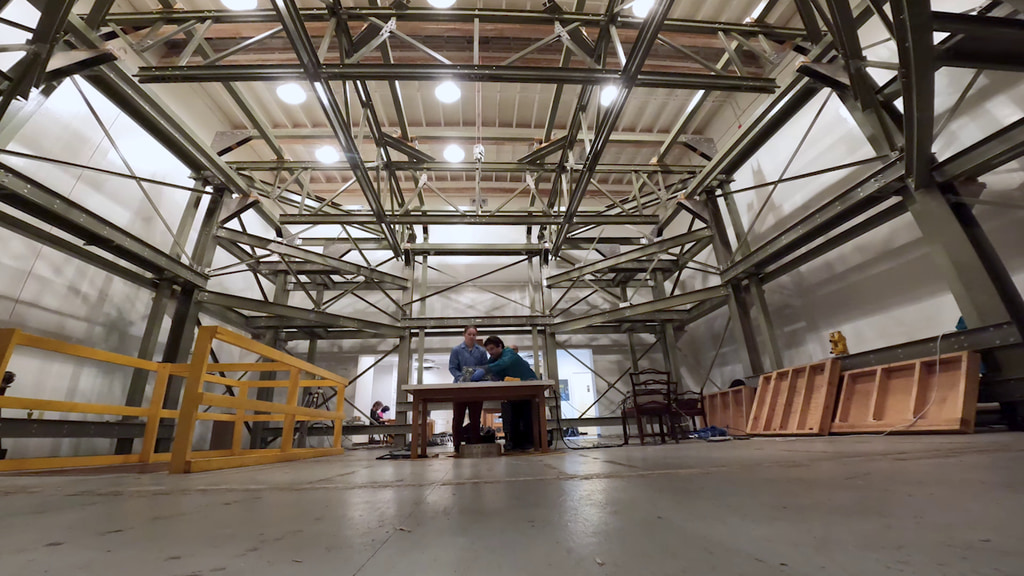
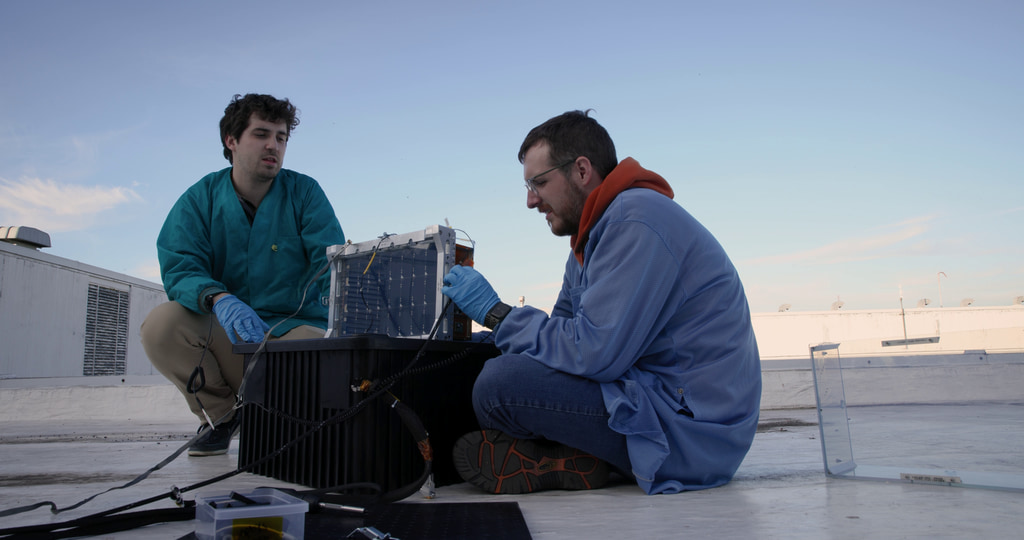



![Music: Charming Noise by Adrien Sahuc [SACEM], Benjamin Sahuc [SACEM]Complete transcript available.](/vis/a010000/a012900/a012957/Screen_Shot_2018-05-14_at_5.20.10_PM.png)
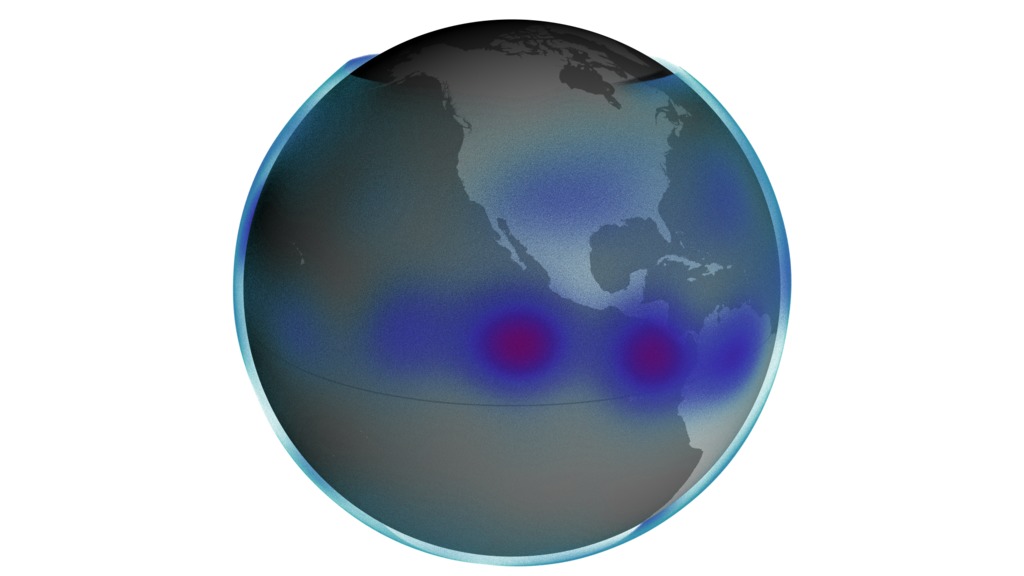
![Music: Devotion by David Goldsmith [PRS]Complete transcript available.](/vis/a010000/a012600/a012607/LARGE_MP4-IceCubeDeployment_large.00428_print.jpg)
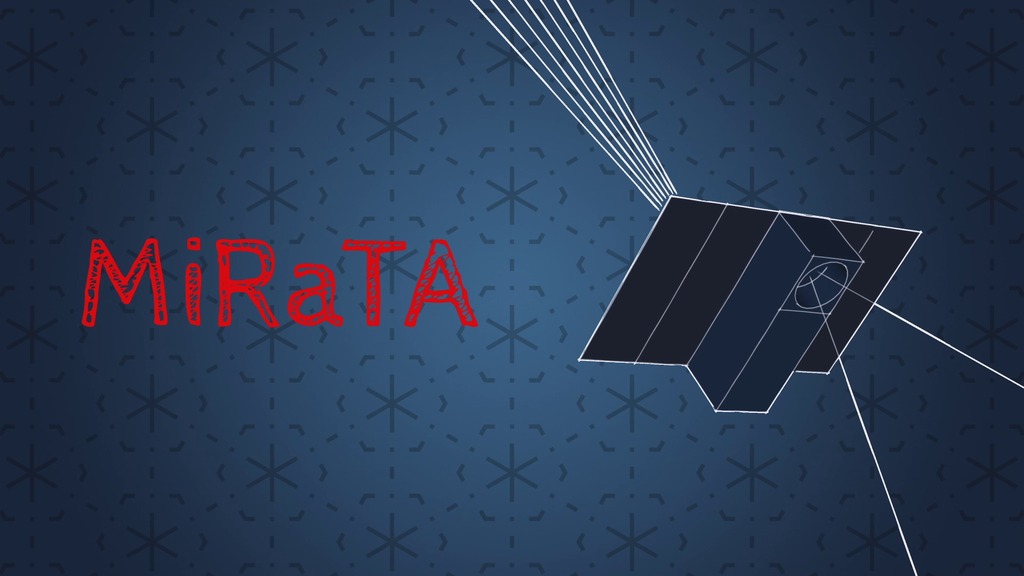
![Complete transcript available.Music credit: 'Cycle of Life' by Philippe Lhommet [SACEM] from Killer TracksWatch this video on the NASA Goddard YouTube channel.](/vis/a010000/a012600/a012602/LARGE_MP4-12602_Dellingr_large.00000_print.jpg)
